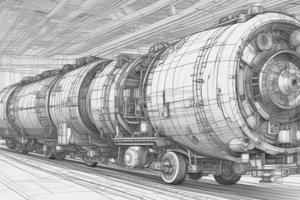Podcast
Questions and Answers
Explain the purpose of engineering drawing and its significance in the field of engineering design and manufacturing.
Explain the purpose of engineering drawing and its significance in the field of engineering design and manufacturing.
Engineering drawing is a two-dimensional representation of three-dimensional objects, providing necessary information about the shape, size, surface quality, material, manufacturing process, etc. It is the graphic language from which a trained person can visualize objects, and it serves as a means of communication in the field of engineering design and manufacturing.
What are the international standards for engineering drawing and their significance?
What are the international standards for engineering drawing and their significance?
The international standards for engineering drawing include Bureau of Indian Standards (BIS), DIN of Germany, BS of Britain, and ANSI of America. These standards ensure that drawings prepared in one country can be utilized in any other country, making engineering drawing the universal language of engineers.
List 5 drawing instruments used in drafting work.
List 5 drawing instruments used in drafting work.
The drawing instruments used in drafting work include drawing board, set squares, French curves, templates, mini drafter.
Describe the traditional material used for drawing boards and its specifications.
Describe the traditional material used for drawing boards and its specifications.
What are the key elements that drawing practice must follow to serve as a means of communication?
What are the key elements that drawing practice must follow to serve as a means of communication?
Flashcards are hidden until you start studying
Study Notes
Engineering Drawing and its Significance
- Engineering drawing serves as a means of communication between designers, manufacturers, and construction teams to convey design intent and specifications.
- It enables the creation of precise and accurate designs, facilitating the production of complex systems and components.
- Engineering drawing is essential in the field of engineering design and manufacturing, as it ensures that designs are translated into reality with precision and accuracy.
International Standards for Engineering Drawing
- International standards for engineering drawing, such as ISO 128 and ASME Y14.5, provide a common language and framework for creating and interpreting drawings.
- These standards ensure consistency, clarity, and accuracy in drawings, facilitating collaboration and communication across different regions and industries.
Drawing Instruments Used in Drafting Work
- T-square: Used for creating straight lines and precise angles.
- Set squares: Used for creating precise angles and checking the accuracy of drawings.
- Pencils: Used for creating freehand sketches and preliminary drawings.
- Erasers: Used for removing errors and correcting drawings.
- Compass: Used for creating circular arcs and curves.
Traditional Material Used for Drawing Boards
- Wooden drawing boards: Made from hardwoods like birch or beech, these boards provide a smooth and durable surface for drawing.
- Specifications: Drawing boards typically measure 24" x 36" (61 cm x 91 cm) and have a smooth, scratch-resistant surface.
Key Elements of Drawing Practice
- Clarity: Drawings must be clear and legible, with minimal ambiguity or confusion.
- Accuracy: Drawings must accurately represent the design intent and specifications.
- Consistency: Drawings must follow a consistent style and notation, ensuring that information is conveyed effectively.
- Completeness: Drawings must provide all necessary information, including dimensions, materials, and tolerances.
- Uniqueness: Drawings must be unique and distinct, avoiding duplication or confusion.
Studying That Suits You
Use AI to generate personalized quizzes and flashcards to suit your learning preferences.




